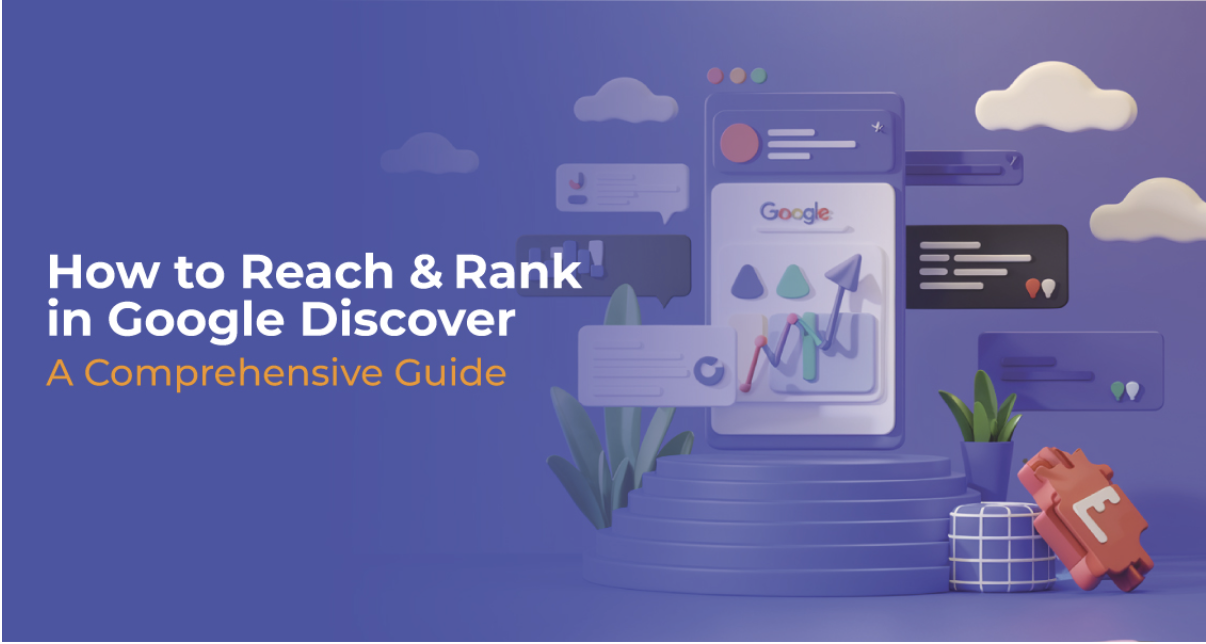How to Reach and Rank in Google Discover: A Comprehensive Guide

How to Reach and Rank in Google Discover: A Comprehensive Guide
Google Discover is a mobile-based content discovery tool that appears on mobile devices. It is designed to showcase articles, blogs, and videos based on user preferences and behaviour. It helps users explore interesting topics by presenting them with articles and other content customised to their tastes. Unlike traditional Google Search, Discover suggests content proactively without the need for the user to enter specific queries, making it a powerful tool for content marketers, publishers, and website owners.
This detailed guide will explore optimising your content for Google Discover, what Google Discover policies to follow, and how to avoid common mistakes to maximise your visibility on this platform.
Table of Contents
- What is Google Discover?
- How Does Google Discover Generate Your Feed?
- Google Discover Traffic: How to Optimize Content
- Key Areas to Focus On for Google Discover Optimization
- Understanding Google Discover Content Policies
- Monitoring Discover Performance in Google Search Console
- Frequently Asked Questions (FAQs)
- Final Words
1. What is Google Discover?
Google Discover is a personalised content recommendation tool on mobile devices, featured in the Google app and the Chrome mobile browser. This customised content feed aims to keep users engaged with high-quality, relevant content based on their interests, hobbies, and browsing history.
Example:
Suppose a user frequently searches for travel articles and follows specific travel blogs. In that case, Google Discover will show them articles about travel destinations, tips for travel planning, and the latest travel news. This preemptive exposure to content increases the likelihood of users discovering your blog, even when not actively searching.
2. How Does Google Discover Generate Your Feed?
Google Discover uses a combination of machine learning and AI algorithms to present content based on a user’s preferences. It considers:
- Google product activity: Your search history, YouTube watch history, and interactions with Discover content.
- Location history and settings: You will receive customised content suggestions based on where you are and the topics popular in your area.
- Topics you follow: Any topics, people, or organisations you have followed through the Google app.
- Browsing and engagement behaviour: Time spent on specific articles, the types of content you engage with, and how often you click on similar content.
Example:
Suppose a user frequently reads health-related articles and searches for information on fitness and diet. In that case, Google will show them health tips, fitness guides, and diet plans in their Discover feed. This is why aligning your content with trending topics and popular user interests can increase your chances of appearing in Google Discover.
3. Google Discover Traffic: How to Optimize Your Content
Optimizing your content for Google Discover involves ensuring that your blog posts or articles align with user interests, are visually engaging, and adhere to Google’s content policies. Here are some essential areas to focus on:
- Understand Google Discover’s Core Functionality: Familiarize yourself with how Google Discover recommends content and the type of content that generally performs well.
- Optimize for Mobile Devices: Since Google Discover is a mobile-first feature, ensure your content is mobile-friendly, loads fast, and delivers a seamless experience for smartphone users.
- Enhance E-E-A-T Signals: E-E-A-T stands for Experience, Expertise, Authoritativeness, and Trustworthiness. Build these elements into your content by including proper attribution, citing authoritative sources, and building a reputed online presence.
Example:
If you are creating content on healthcare, ensure that you link to credible health organizations, provide author credentials, and maintain transparency in your information.
- Focus on User Intent: Discover’s content is influenced heavily by what users like to read. Ensure your content aligns with current trends, user searches, and emerging topics.
- Use High-Quality Images and Videos: Google Discover heavily relies on visuals to capture user attention. Use high-resolution images (minimum 1200px width), ensure they are well-optimized, and avoid site logos as images.
- Optimize Your Titles, Headlines, and Meta Descriptions: Use concise and engaging headlines that reflect the core of your content. Avoid clickbait or misleading titles.
Example:
If your article is about “10 Best Places to Visit in Goa,” ensure that your title is clear and the content reflects what the user expects.
4. Key Areas to Focus On for Google Discover Optimization
4.1 Understand Google Discover’s Mechanism
Google Discover uses a mix of machine learning and Google’s Knowledge Graph to determine content that matches user interests. It employs:
- Google News AI/ML will display various perspectives on trending news.
- Topic Layer in the Knowledge Graph to analyze and present content relevant to a user’s growing interests.
4.2 Optimize for Mobile Experience
Since Google Discover is predominantly mobile, ensure your site is optimized for small screens. Use a responsive design, optimize images and videos, and provide easy navigation on mobile.
4.3 Use High-Quality Visuals
High-quality images and videos can significantly boost your Discover performance. Use compelling visuals that enhance the story, meet Google’s size requirements, and are optimized for fast loading.
4.4 Create Engaging, Evergreen Content
Google Discover values content that is both timely and evergreen. Create articles that are appropriate in the long term and update them periodically.
Example:
A travel website post titled “The Ultimate Guide to Backpacking in India” could be refreshed with new images, updated routes, and the latest travel tips.
5. Understanding Google Discover Content Policies
Content featured in Google Discover must adhere to specific guidelines to provide safety, credibility, and transparency. Let’s review some critical content policies and their impact on your Discover visibility:
5.1 Dangerous Content
Content that promotes illegal activities or causes physical harm is strictly prohibited.
5.2 Deceptive Practices
Avoid using deceptive tactics such as fake news or clickbait. For example, an article promising a “miracle cure for diabetes” without scientific backing would be considered misleading.
5.3 Harassing and Hateful Content
Any form of content that targets specific individuals or communities with hate speech or harassment will not be tolerated.
5.4 Misleading Sponsored Content
If you publish sponsored content, clearly disclose it. Avoid blending advertisements with editorial content.
6. Monitoring Discover Performance in Google Search Console
Tracking your content’s performance in Google Discover is essential for understanding how well your optimization efforts work. To monitor Discover traffic:
- Log into Google Search Console.
- Go to Performance.
- Select Discover to view insights like clicks, impressions, CTR, and average position.
This data helps identify which content performs best and reveals areas that need improvement.
7. Frequently Asked Questions (FAQs)
Q1: What is the difference between Google Discover and Google Search?
Google Discover is a personalised content feed that demonstrates content based on interests. In contrast, Google Search shows results based on specific questions entered by users.
Q2: Is Google Discover beneficial for my content?
Yes, it helps expose your content to a broader audience based on their interests, driving significant traffic to your site.
Q3: Does Google Discover show ads?
Yes, it can display sponsored content clearly labelled as such.
Q4: Why is my content not appearing in Google Discover?
Ensure your content follows Google’s policies, aligns with user interests, and is mobile-friendly.
Optimizing your content for Google Discover can be a game-changer for your site traffic and brand visibility. By adhering to Discover’s content policies, focusing on user intent, and maintaining a high-quality standard, you can significantly improve your chances of occurring on this powerful content discovery platform.
8. Final Words
Following these best practices will help you tap into a vast audience, boost your content’s reach, and establish a robust online presence. Start leveraging Google Discover today and watch your content engagement soar!

Blog Admin:
Ravinder Bharti
CEO & Founder - Public Media Solution
About: Ravinder Bharti is the Founder and CEO of Public Media Solution,
a leading
marketing, PR, and branding company based in India.









